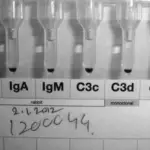Febrile non-hemolytic transfusion reaction is a reaction that occurs as a result of antibodies attacking the white blood cells and is characterized by increased body temperature.
What is the Pathology of Febrile Non-Hemolytic Transfusion Reaction?
The pathology of febrile non-hemolytic transfusion reaction is:
-Etiology: The cause of febrile non-hemolytic transfusion reaction is the accumulation of cytokines in the blood.
-Genes involved: None.
-Pathogenesis: The sequence of events that lead to febrile non-hemolytic transfusion reaction during blood storage is the development of antibodies against the leukocytes. These antibodies fight the white blood cells, causing a reaction once transfusion is done.
-Morphology: NA.
-Histology: NA.
How does Febrile Non-Hemolytic Transfusion Reaction Present?
Patients with febrile non-hemolytic transfusion reaction typically affect males and females present at an age range of childhood to adulthood. The symptoms, features, and clinical findings associated with include fever, chills, and malaise.
How is Febrile Non-Hemolytic Transfusion Reaction Diagnosed?
Febrile non-hemolytic transfusion reaction is diagnosed physical examination, vital signs monitoring.
How is Febrile Non-Hemolytic Transfusion Reaction Treated?
Febrile non-hemolytic transfusion reaction is treated by management of the symptoms which include antipyretics and leukocytes therapy, steroids and stopping the blood transfusion.
What is the Prognosis of Febrile Non-Hemolytic Transfusion Reaction?
The prognosis of febrile non-hemolytic transfusion traction is good.



